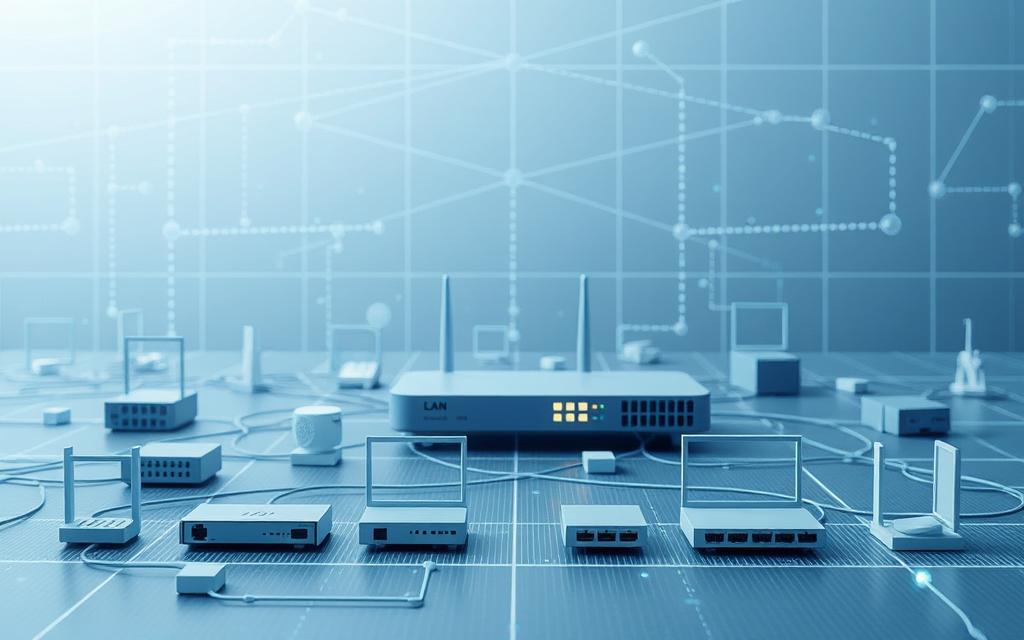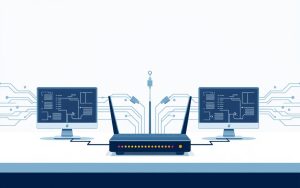Computer networks revolutionize how we communicate and share resources. They create seamless channels between computers and digital systems. These networks enable sophisticated data sharing across multiple devices and locations.
Networks have evolved since ARPANET’s development in the late 1960s. They’ve become critical components of modern digital ecosystems. About 90% of organizations use networks for resource sharing.
Strategic network implementation can cut operational costs by up to 30%. It also greatly improves communication efficiency. Networked environments can boost workplace productivity by 40%.
Computer networks reshape communication, collaboration, and information exchange. They play a vital role in our increasingly digital world. Understanding their functions provides insights into technology’s impact on society.
Understanding Computer Networks: Core Components
Computer networks are the backbone of modern digital communication. They connect devices through complex network components for seamless data exchange. These systems rely on sophisticated hardware and precise protocols to function effectively.
Various critical elements work together in network infrastructure. They transmit and manage information across digital landscapes.
Network Nodes and Connection Points
Network nodes are fundamental connection points in a digital ecosystem. They include personal computers, servers, specialized networking hardware, and endpoint devices.
Each node has a unique network address. This allows precise communication and resource sharing.
Essential Hardware Components
Robust network hardware forms the physical foundation of digital communication. Key hardware components are crucial for effective networking.
| Device | Primary Function |
|---|---|
| Routers | Direct network traffic between different networks |
| Switches | Connect devices within a single network |
| Modems | Convert digital signals for transmission |
| Firewalls | Provide network security and access control |
Network Protocols and Standards
Protocols are the communication rulebooks that govern how network components interact. The TCP/IP model is a crucial standard for networking.
It defines how data packets are transmitted and received across network infrastructures. This ensures consistent and reliable communication.
Modern networking uses advanced technologies like software-defined networks. These solutions ensure efficient and secure digital communication across various platforms.
Automated scaling is another feature of modern networks. It helps manage resources effectively as network demands change.
What Is the Primary Function of a Computer Network
https://www.youtube.com/watch?v=eqqQ4fEd0cM
Computer networks are the backbone of modern digital communication. They enable complex interactions between devices and systems. The primary function of a computer network provides critical infrastructure for data transmission and resource sharing.
Network functionality transforms how we communicate and collaborate. It includes seamless communication, centralized data management, and efficient resource sharing.
- Seamless communication through email, messaging, and video conferencing
- Centralized data storage and management
- Efficient resource sharing among multiple devices
- Enhanced collaboration for teams and organizations
Data transmission is a crucial element of network operations. Networks break information into packets for quick and efficient data movement. Networking technologies have changed how we share and access information.
Resource sharing is another key network function. Companies can optimize their tech infrastructure through shared resources. This approach reduces costs and streamlines workflows through smart network design.
Networks transform isolated computing devices into powerful, interconnected systems that drive innovation and communication.
Computer networks connect people, devices, and information across the digital landscape. They range from small office networks to global communication systems.
Network Types and Their Distinct Purposes
Computer networks connect devices across various geographical scales. They help organizations and individuals share resources and communicate effectively. Understanding network types is key to optimizing digital strategies.

Networks are grouped by geographical coverage, transmission capabilities, and organizational needs. These categories help choose the right network setup for different situations.
Local Area Networks (LANs)
LANs are perfect for compact spaces like offices, schools, and hospitals. They offer short-distance connectivity and high-speed data transmission. LANs typically cover a single building or campus.
These networks can transmit data at speeds from 2 Mbit/s to 10 Gbit/s.
Wide Area Networks (WANs)
WANs connect computers across vast geographical regions. They form the backbone of global communication infrastructure. WANs link networks in different locations, supporting enterprise-level communication.
These networks can have varied ownership and management models.
Metropolitan Area Networks (MANs)
MANs fill the gap between LANs and WANs. Typically owned by cities or government entities, they cover a city or large campus. MANs offer intermediate data transmission capabilities.
They provide shared infrastructure for multiple organizations. This enhances regional communication networks.
Each network type is vital for modern digital communication. They enable efficient data sharing and collaboration across different scales and contexts.
Network Architecture and Security Features
Network architecture is crucial for modern digital infrastructure. It helps organizations design robust communication systems. Different network setups affect performance, reliability, and security.
Network design involves complex data protection and connection methods. Organizations must carefully assess their network layout. This ensures optimal data flow and reduces potential weaknesses.
- Full mesh topologies provide maximum redundancy
- Partial mesh networks offer balanced connectivity
- Point-to-point links create direct communication channels
- Multipoint networks enable shared resource access
Security protocols are vital for protecting network infrastructure. Advanced encryption and access controls safeguard sensitive information. By 2025, the global network security market may reach $37 billion.
Modern networks use advanced tech for better data protection. VPNs, multifactor authentication, and encryption are now standard. These practices help organizations achieve comprehensive network security.
Effective network design balances performance, scalability, and security to meet evolving digital communication needs.
Well-designed networks boost digital transformation success by 40%. This shows how important thoughtful network design is today. Organizations need to prioritize network architecture for better outcomes.
Conclusion
Computer networks have evolved dramatically since the 1950s. They’ve grown from simple military systems to a global infrastructure. Today, they connect billions of devices worldwide, driving innovation and reshaping organizations.
Networking’s future continues to push technological limits. Connectivity ranges from Personal Area Networks to Wide Area Networks. Businesses rely on advanced network architectures for streamlined operations and secure remote access.
Network security and efficiency are crucial in modern times. Sophisticated tools protect sensitive data from threats. Firewalls, intrusion detection systems, and centralized logging are common safeguards.
The TCP/IP model and new technologies keep evolving. This ensures computer networks remain vital for digital communication. They also support ongoing technological progress in various fields.
Computer networks are more than just infrastructure. They’re the nervous system of our connected world. These networks enable global communication, innovation, and collaboration at unprecedented levels.







